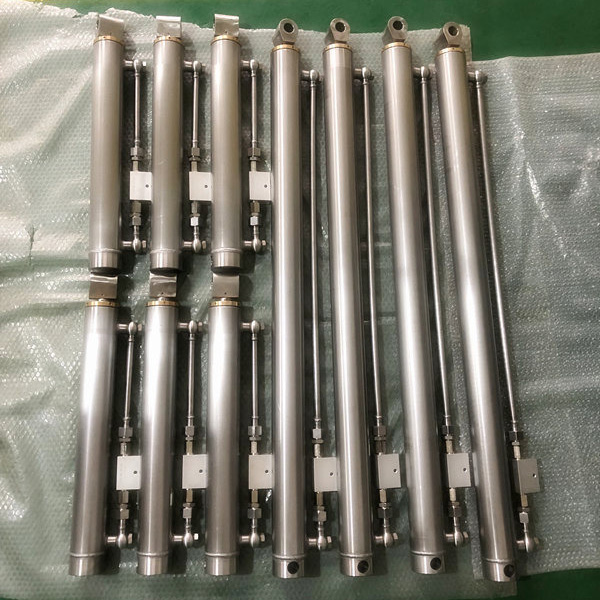The role of the Stainless
Hydraulic Cylinder dust ring
All Stainless Hydraulic Cylinder must be equipped with a dust ring. When the piston rod returns, the dust-proof ring will scrape off the dirt stuck on its surface to protect the sealing ring and the guide sleeve from damage. The double-acting dust ring also has an auxiliary sealing function, and its inner lip scrapes off the oil film adhering to the surface of the piston rod, thereby improving the sealing effect. Dust seals are extremely important to protect critical hydraulic equipment components. Infiltration of dust will not only wear, but also greatly wear the guide sleeve and piston rod. Impurities entering the hydraulic medium will also affect the function of the operating valve and pump. In bad conditions, these devices may also be damaged. The dust ring can remove any dust on the surface of the piston rod, but does not damage the oil on the piston rod, which is also beneficial to the lubrication of the seal. Therefore, it is necessary to install a dustproof ring on the outside of the piston rod sealing ring, near the end surface of the cylinder.
The function of the Stainless
Hydraulic Cylinder dust ring
When the dust ring is designed, it must not only adapt to the piston rod (dynamic function), but also must play a sealing role in the trench (dynamic function).
Dynamic function of Stainless Hydraulic Cylinder dust ring
For an effective dust ring, the contact force of its lip with respect to the piston rod must be large enough. Elastic materials with relatively high hardness are easy to achieve this effect. Polyurethane with a hardness of 94 is a material particularly suitable for dust seals. Its characteristics also include high modulus (hardness), good wear resistance and low compression. This material can be used in most applications in the range of -40 to 100°C.
Static function of Stainless
Hydraulic Cylinder dust ring
The non-reinforced single-acting dustproof ring designed for closed installation grooves is difficult to play an effective sealing role in the groove. This is because the dustproof ring is loosely installed in the groove. Only the contact between the sealing lip and the piston rod provides the sealing force between the dust ring and the cylindrical surface. When the temperature decreases, the entire dust ring shrinks, and the risk of leakage between its outer diameter and the groove will appear. To achieve satisfactory results, this situation must be compensated in the design of the dust ring.
Classification of Stainless Hydraulic Cylinder dust ring
The dustproof ring is installed on the outside of the end cover of the Stainless
Hydraulic Cylinder to prevent external contaminants from entering the cylinder. According to the installation method, it can be divided into a snap-in type and a press-in type.
The basic form of the snap-in dust ring is the most common. As the name suggests, the dust ring is stuck in a groove on the inner wall of the end cover and is used in less harsh environmental conditions. The material of the snap-in dust ring is usually polyurethane, and there are many variations of the structure.
Some variants of the snap-in dust ring. The press-in dust ring is used under severe and heavy-load conditions. It is not stuck in the groove, but is wrapped with a layer of metal to increase the strength of the polyurethane material. Inside the Stainless Hydraulic Cylinder end cover. There are also many types of press-in dust rings, which are also divided into single lip and double lip.
Press-in dust ring and some variants of piston rod seals. Piston rod seals are also called U-shaped cups. They are the main piston rod seals. They are installed inside the end cover of the Stainless
Hydraulic Cylinder to prevent hydraulic oil from leaking. The piston rod sealing ring is made of polyurethane or nitrile rubber. In some cases, it needs to be used with a support ring (also called a retaining ring). The support ring is used to prevent the sealing ring from being squeezed and deformed under pressure. The piston rod is sealed There are also many variations of the circle.
Precautions for the use of dust ring for Stainless
Hydraulic Cylinder
All dust-proof rings cannot bear pressure, that is, they have no sealing function. Their function is only to prevent dust and must be used in conjunction with other seals; the lip of the dust-proof ring should be designed to avoid the opposite side of the piston rod hole or wrench. Contact and cause to be cut.
Material of Dust Ring of Stainless
Hydraulic Cylinder
Generally made of polytetrafluoroethylene (PTFE) material; the dust ring is to remove the dust, sand, rain and frost attached to the outer surface of the cylinder by the reciprocating piston rod to prevent external dust and rain from entering the inside of the sealing mechanism Parts. The sealing material used may be customized to polyurethane, rubber, or PTFE. Dust seals are mainly used as one of the special seals in the iron and steel industry.

